TL;DR
- This piece uses a conceptual lens to study yield farming, i.e., earning compounding returns on crypto assets. It illuminates the fundamental exchange of value that yield farming entails.
- Yield farmers passively provide five forms of value: operating the network, lending to traders, providing liquidity, governing protocols, and raising visibility.
- Yield farmers are compensated for these activities by a mix of users, non-farming protocol owners, and each other.
Introduction
Warren Buffet warns that you should "never invest in a business you cannot understand." So an investor could be forgiven for looking at yield farming — a landscape full of free money ("airdrops") and scams ("rug pulls"), ruled by characters calling themselves "degens" and "apes" — and running away.
However, a closer examination reveals that yield farming is simply another type of business activity, one which provides value by bearing risk. Obscured by the frenzy of new protocols, misspelled slang, and coordinated capital flows, yield farming rewards entrepreneurial efforts to build new platforms.
In this article, we examine yield farming through a fundamental economic interpretation. In particular, we ask two questions:
- What core value do yield farmers create, for which they are compensated?
- Who pays that compensation, whether explicitly or implicitly?
For many traditional businesses, the answers are straightforward. For instance, our local sandwich shop provides a range of services — sourcing quality ingredients, assembling sandwiches, and wiping tables — and diners pay for those services directly. Yield farming is not much more complicated. Jargon aside, most yield farming strategies engage in five core types of economic activity, in passive and delegated ways:
- Farmers support network operations, such as validating transactions.
- Farmers provide lending for traders.
- Farmers provide liquidity to token holders.
- Farmers provide management and governance to protocols.
- Farmers enhance protocols’ marketing efforts.
This piece examines yield farming through these simple, abstract lenses to help current and potential farmers understand their opportunities and evaluate their risk profiles. Since specific strategies are constantly rising and falling, we will avoid diving too deep into the mechanics of any particular trade. Instead, we will explore the underlying conceptual bedrock, which is broadly applicable to both current and future farming opportunities.
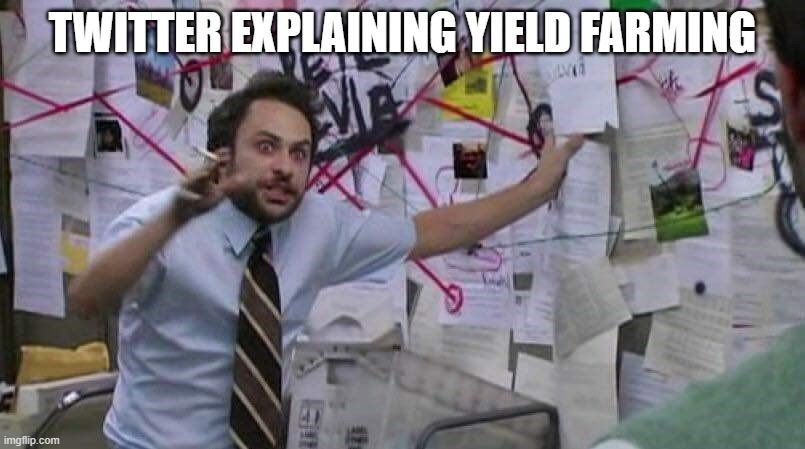
What is Yield Farming?
The phrase "yield farming" is tossed around in many contexts. Our first task is to settle on a concrete and precise definition. Yield farming is managing passive strategies to earn well-defined interest on cryptocurrency positions.[1]
- Managing passive strategies: Yield farming is hard work, and farmers must constantly find ideas, manage risks, and rebalance positions. However, we consider these strategies passive because, once the upfront cost to find an opportunity is incurred, the deployed position earns a return with little to no further action. This framing contrasts with active ways of earning compensation, e.g., running validator nodes or managing algorithmic market-making strategies, which require ongoing technical labor.
- Well-defined interest: To make our definition more useful, we focus on strategies that have some well-defined schedule of interest payouts. There are many forms of well-defined interest schedules: fixed and floating, simple and complex. The schedule itself is what distinguishes yield farming from simple buy-and-hold strategies, e.g., buying coins or NFTs hoping for price appreciation, as these do not have any definite payouts.
Yield farming can further be defined, with respect to a traditional buy-and-hold strategy, as a way to earn extra returns while holding exposure to those same positions. To help better understand this definition, consider some examples from the world of traditional finance.
- An investor who holds cash in her standard bank account would not be yield farming, since this is the default action and does not involve managing a strategy. But an investor who constantly opens new high-yield savings accounts to earn bonuses and promotional rates would be yield farming cash positions.
- Similarly, a consumer who uses a single credit card would not be yield farming, but one who actively manages a portfolio of cards to maximize miles, bonuses, and other rewards would be. In this case, the underlying asset would be a line of credit.
- An investor who simply holds a stock would not be yield farming, since again this is the default buy-and-hold action and earns no well-defined interest. However, an investor who boosts returns by lending their shares to short sellers would be.
- Fixed-income investors who buy and hold fall into a grey area. If we consider cash as the underlying asset, an investor who lends that cash to a borrower would indeed be yield farming, since they would be earning interest passively on a cash position. But in many cases, we tend to think of a fixed-income security, e.g., a bond, as the underlying asset, in which case the investor is not earning any extra yield.
Extra returns do not come freely, of course. In exchange for this compensation, yield farmers take on risks and provide a range of passive benefits to the protocol. We will now outline the five ways they do so.
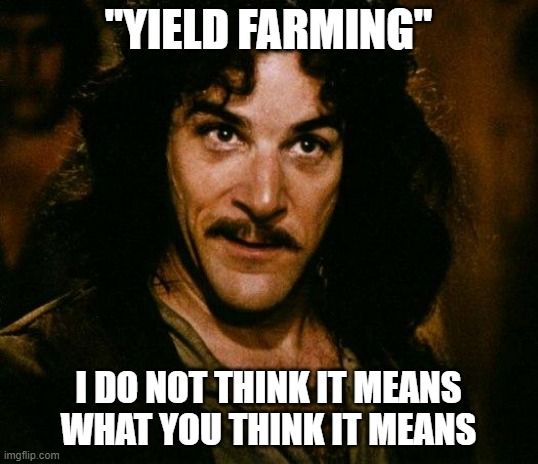
Activity #1: Network Operations
The most basic function in crypto is correctly and securely operating the network. This is done by node operators, usually called validators, who process transactions in exchange for payments in the network’s native token. While many networks rely on computationally-intensive problem-solving to incentivize good behavior ("proof-of-work" networks), others rely on validators posting collateral ("proof-of-stake" networks). That collateral can be partially or fully seized if a validator underperforms or misbehaves.
In turn, the first major form of yield farming is for farmers to delegate tokens to high-quality validators, i.e., validators with reliable and honest performance, in exchange for a share of proceeds. If yield farmers allocate to low-quality validators, those validators will face negative consequences, i.e., forfeited collateral, and farmers will bear that burden.
There are many examples, but consider two prominent ones that are more retail-facing. First, traders on Coinbase have the option to stake their Ether on the platform, i.e., delegate their Ether to Coinbase as it participates in upgrading the Ethereum network to Ethereum 2.0, in exchange for interest of around 5% (at the time of writing). Second, Terra traders can use the Terra Station app to stake their Luna, i.e., delegate their Luna tokens to one of several different validators who process the Terra network, in exchange for rewards.
Consider the two original questions: what economic value do farmers create and who compensates them?
- Yield farmers allocate their holdings towards high-quality validators, allowing the network to run more efficiently and securely.
- Rewards are paid by network participants, who pay fees to validators in exchange for using the network. Validators then remit a portion of those fees back to farmers.
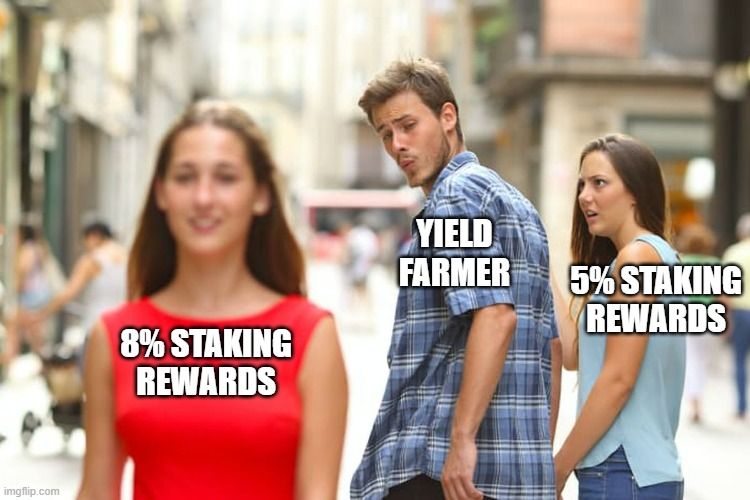
Activity #2: Lending
The explosion of decentralized protocols, known as "DeFi Summer" in mid-2020, dramatically changed the face of crypto lending activity. Prior to this point, lending relied mostly on large and centralized institutions, but since 2020 a new wave of decentralized protocols has allowed individual traders to participate in a wide range of lending activities.
Thus, the second major form of yield farming is a generalization of the first. Rather than only lending to validators, traders can lend cryptocurrency positions to anyone. In particular, yield farmers place tokens in funding pools, and borrowers automatically borrow from those pools using suitable collateral.
Many examples of these types of protocols exist, with Aave, Compound, and Anchor as some of the most popular. These protocols typically accept deposits in a base asset — one that already exists outside the protocol, e.g., UST in the case of Anchor — which can be lent out to borrowers. These protocols keep track of deposits by issuing the lender a new synthetic token (e.g., "aUST" for Anchor), which lenders can use to redeem the original position and the accrued interest later.
For now, almost all protocols have focused on over-collateralized lending. Lenders thus face the risk of the collateral depreciating more quickly than it can be liquidated. However, a few protocols such as TrueFi and Goldfinch are expanding into the uncollateralized lending space by vetting borrowers, using their knowledge of some off-chain, real-world information. Future yield farmers will likely choose between making fully collateralized loans and taking on the default risk of borrowers more directly.
As before, we ask ourselves the same two questions: What economic value do farmers generate and who pays them?
- Yield farmers allocate holdings towards capital-constrained traders, which allows for those traders to express views on asset prices more efficiently. In the future, yield farmers may also provide value by allocating holdings towards higher-quality borrowers and projects.
- Farmers are compensated by borrowers, who pay continuous interest back to farmers (with protocols taking a cut). While some protocols temporarily guarantee fixed interest rates, most use floating rates that allocate supply and demand.

Activity #3: Liquidity
Liquidity provision, like lending, has been democratized and massively expanded by DeFi protocols. Previously, only centralized exchanges and professional market makers could successfully muster the capital, technical expertise, and ongoing attention needed to provide liquidity. Today, retail traders can passively do so too.
This is the third major form of yield farming. Farmers deposit cryptocurrency positions into common liquidity pools (known as "automated market makers" or AMMs). Traders who need liquidity can swap tokens against these pools — often paying explicit fees in addition to spreads to do so. Liquidity providers earn these fees and/or spreads by facilitating two-way liquidity, but also bear the risk of capital losses if the fundamental exchange rate changes (and does not revert). This contrasts with active liquidity providers, who frequently adjust their positions as the exchange rate drifts.
Examples of major protocols running liquidity pools for yield farmers include Curve, Uniswap, Sushiswap, among others. These pools act as centralized liquidity hubs, facilitating trades between many different pairs of assets.
In returning to the same two questions, the answer to the first question — what value do farmers provide? — is straightforward.
- Yield farmers provide liquidity to those who need it, allowing them to enter and exit positions with minimal market impact.
But answering the second question — who pays for that value? — is more complicated. In particular, there are three ways that liquidity providers are compensated.
- First, AMMs distribute direct rewards — namely, trading fees and spreads — to liquidity providers. The rewards are directly paid by the users who take liquidity from the pool.
- Second, AMMs issue rewards in their own native tokens, e.g., Curve issues the CRV token. (Note that Curve was indeed the first protocol to successfully operationalize this model, which has since become wildly popular and widely imitated.) In addition to their direct economic value, these tokens usually come with special rewards schemes (and governance rights).
- For instance, a farmer on Curve can boost their rewards on a pool up to 2.5x from the base amount by holding a substantial amount of CRV tokens relative to the liquidity they provide.
- As a result, rewards are paid by two constituencies. First, farmers who have small CRV positions earn lower fees from liquidity provision, implicitly subsidizing farmers with large CRV positions. Second, non-farmers who hold CRV positions are diluted through CRV supply inflation, thus again subsidizing farmers.
- Third, individual protocols may pay for rewards to those who provide liquidity for their specific token. In practice, they operationalize this by buying governance tokens of the large liquidity protocols (directly or indirectly) to redirect extra rewards to their token’s pool. This method is discussed more in the next section.
Some activities look like liquidity provision, but can be subtly different. For example, Olympus DAO famously offers extremely high yields (currently 900%) for staking its OHM tokens. However, these yields are granted through hefty token dilution, and they are largely compensation for marketing (which we discuss more in the final section).[2]

Activity #4: Management and Governance
Although "code is law" is frequently cited as the blockchain ideal, much of crypto remains a hands-on activity. Capital needs to be directed, protocols upgraded, and systemic threats addressed. Most such tasks are accomplished via active and decentralized means — individual stakeholders write and review code, vote on proposals, etc. But in the last few years, pooled management systems have grown in popularity, particularly in directing capital.
The fourth major form of yield farming is to power those pooled systems and thus manage tokens in passive and delegated ways. For instance, the protocol Convex has been highly successful in directing liquidity on the Curve platform across liquidity pools. The protocol Yearn has found similar success at a higher level, allocating assets across multiple lending and liquidity protocols.
This reminds us that a single yield farming strategy may provide value in multiple ways. For instance, a yield farmer could provide liquidity on Curve directly, or she could provide liquidity on Curve through Convex. She earns rewards for providing liquidity in both cases, but earns extra rewards for doing so more efficiently in the latter case.
The answers to our two core questions — the value provided and the compensation received — are more subtle than in previous sections. In particular, there are two ways in which yield farmers earn their keep through managing protocols. The first subset is value-creating:
- Yield farmers create surplus through more efficient management. Using the same examples of Convex and Yearn, these protocols can reallocate liquidity towards particular markets more quickly and cheaply than a group of disaggregated traders. (Note that aligning incentives towards the most useful markets is a subject of lively and evolving debate.)
- Farmers are compensated both explicitly and implicitly:
- First, farmers earn better returns by redirecting resources towards high-value opportunities. They are then compensated by their new end users, such as borrowers or liquidity utilizers.
- Second, farmers save on transaction costs by utilizing such services. This can be highly significant — fixed fees on the Ethereum network sometimes exceed $100 per transaction, which makes larger transactions much more attractive. (Imagine an ATM that charged $100 to withdraw. You’d want to take out a lot each time!) Pooled protocols amortize these fees, so the portfolio can be rebalanced more frequently. Farmers can also save on individual effort through automated portfolio management, where the protocol automatically identifies and transfers funds towards the current best opportunities.
However, farmers can also profit from management through value extraction:
- Farmers can take advantage of protocol-based rewards (as with Curve) either through pooled structures ("aggregators") or individually, but aggregators make more efficient use of reward-boosting mechanisms. Thus, on the margin, the increased compensation is funded by small liquidity providers and token holders who do not provide liquidity. In short, value is being transferred rather than created.
- In some cases, farmers can be directly “bribed” to allocate tokens to specific pools.[3] These bribes frequently come from new protocols aiming to bootstrap liquidity, incentivize usage, and attract attention. But this is even costlier for independent farmers, who see rewards diverted away from their own pools, and non-farming token holders, for whom all rewards represent inflation.
As builders, we at Jump hope that management and governance will continue to evolve, increasing the ratio of value-creating to value-extractive activities over time. For instance, yield farmers could be incentivized to support useful code upgrades just as they are currently rewarded for selecting high-quality validators. Defenses like square root voting may also help make bribery, as well as other methods for large players to amass voting power, less viable.
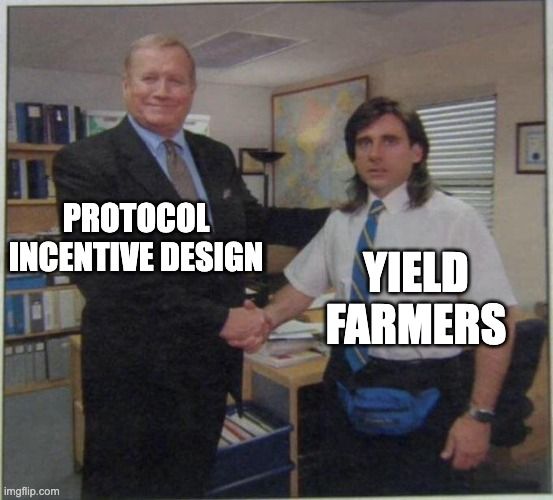
Activity #5: Marketing
Finally, yield farming allows protocols to leverage one critical and practical insight: big numbers are great marketing! In particular, the more TVL ("total value locked," i.e., assets allocated) a protocol has, the more attention it garners, the more trust it earns, and the more likely it is to emerge as a leader in a crowded field. TVL may also influence a protocol’s perceived valuation. While the concept of "fair value" is still nascent in crypto, TVL multiples are commonly cited, similar to the way companies use multiples of book value and asset managers use multiples of AUM. Amidst today’s Cambrian explosion of protocols, getting on the leaderboard can be one of the most effective ways to stand out.
Thus, the final value provided by yield farmers is enhanced visibility and trust through asset allocation. To keep that value within the system, protocols often reward illiquidity as a means of "leasing" attention and usage, which gives them time to build and mature. Specifically, protocols ask farmers to purchase and lock tokens in exchange for token distributions — with larger rewards for longer lockups. Of course, part of this exchange is that locked holders, who cannot respond to market conditions, bear substantial macroeconomic price risk relative to liquid ones.
Chris Dixon outlines this mechanism more generally in his essay on token incentives. For users, token distribution helps bootstrap additional utility, which takes years to create, by exchanging some of it for financial utility that can be realized immediately. As a bonus, lockups restrict supply (mitigating selling pressure) and align incentives for yield farmers towards the protocol’s success. That is: at the beginning you are there for the rewards, at the end you are there for the utility — and the token distribution plan succeeds to the extent that it facilitates a smooth transition.
Looking at our core questions of fundamental economic value and compensation for the last time, we arrive at the following:
- Yield farmers provide increased TVL to a given protocol, driving higher awareness and more usage.
- Yield farmers are compensated by the protocol, which typically provides rewards in the native token. This means that, in the short run, non-farmers pay for these rewards by bearing the inflationary burdens. However, in the long run, the protocol hopes to be successful in creating value and attracting new users. In this case, later generations of holders pay for the marketing benefits provided by the early (yield farming) generations.
Conceptually, this channel is the most nebulous and prone to Ponzi-like dynamics. Indeed, protocols must grapple with key questions, such as whether they can keep users after the implicit marketing budget ends. But there is some precedent for success from the startup world, where "blitzscaling" — the strategy by which VC-funded startups massively subsidize users to gain market share before raising prices — has proved effective if finicky. Crypto is now copying that playbook, incurring deep expenditures upfront with the chance of realizing enormous value over time. Channeling the Lindy effect, protocols hope to become a fixture on the crypto scene in the short run to ensure success in the long run.
Rewards-driven marketing is a tightrope that must we must tread carefully. Protocols that offer no rewards will languish without attention. On the other hand, highly aggressive protocols (e.g., ones that offer 1000% staking yields) attract only yield farmers, and there are few non-farmers to power the rewards. This leads to short-term spikes from pools of "mercenary liquidity," but long-term collapses.

Financialization and Scaling Yield Farming
Despite their numerous variations, yield farming strategies at their core are fairly simple. Farmers passively provide value to protocols, in exchange for which they receive both direct and indirect compensation. However, there is one final ingredient in the mix: financialization. Crypto has developed a robust ecosystem of financial protocols, allowing yield farmers to transfer assets freely and to take generous leverage. This is how many yield farmers multiply high base yields to even more enticing levels (e.g., 20% to 100%).
While a further discussion of the use of leverage in yield farming is out of scope for this piece, we will mention one common example: liquid staking. This is where farmers deposit a base token into a protocol and receive a synthetic tradable token in exchange. As long as the synthetic token is accepted as collateral by other lending protocols, farmers can leverage their position. Namely, a farmer could deposit the base token (e.g., ETH), receive a synthetic token representing that claim (e.g., sETH), borrow ETH against that synthetic token as collateral, deposit that ETH, receive sETH against it, etc. This sequence is by no means the only one, and the ability to short or fractionalize adds even more complexity to the mix.
But it is important to stress that, while financialization can amplify yield farming opportunities, the underpinning theory remains the same. Farmers are compensated for bearing risk and passively providing value, while financialization connects different parts of the ecosystem and expands the menu of risk-return profiles.
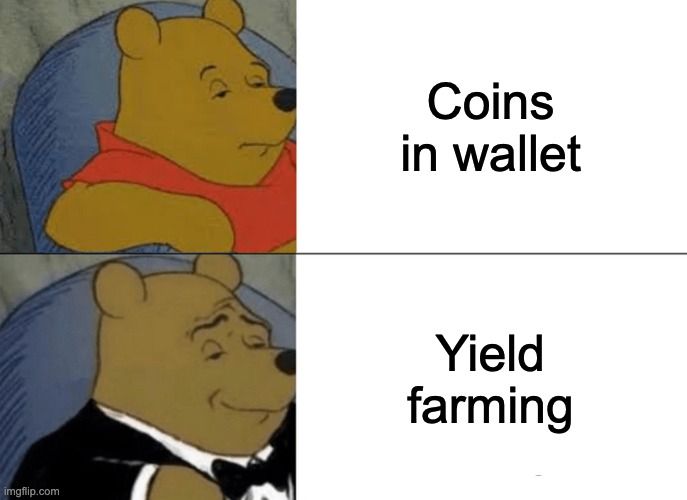
Conclusion
At their core, yield farmers and traditional farmers are not so different. Both take risks (whether price risk or weather risk), provide value (whether creating buzz or creating food), and earn returns. We hope that, with the fog of jargon and insider lingo lifted, yield farming can be seen as just another economic activity that helps the crypto ecosystem run more efficiently.
But, like traditional farming, yield farming is not an easy business. Despite the conceptual simplicity, yield farming in practice involves an ability to find under-appreciated opportunities, move crypto positions rapidly, and understand nuanced risks in smart contracts. Aspiring yield farmers should brace themselves for mistakes and only deploy the holdings they are prepared to lose.
As the industry matures, we believe that these problems will ease and that a broader set of individuals will be able to participate safely. Yield farming will then deliver on crypto’s broader promise — democratizing finance and allowing anyone, regardless of sophistication or wealth, to provide these core sources of value.
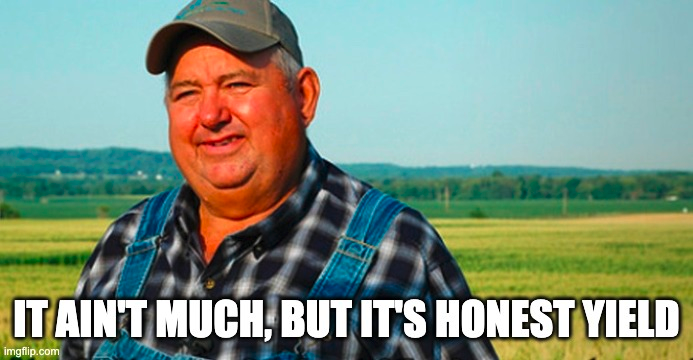
Please let us (Lucas and Nihar) know what we got wrong, as we'd like to understand this subject matter thoroughly and correctly. Thanks to the research team at Jump Crypto and especially to Sam Haribhakti and Maher Latif for feedback. This note does not constitute financial advice.
- Although “interest” in traditional finance refers more strictly to value paid by borrowers for extension of credit, we will continue with the broader crypto definition here. ↩︎
- In particular, these yields are powered through frequent rebasing of the token (three times daily). Rebases do not create value, but just redistribute it. For instance, a 900% APY requires a 10x increase in the token supply, which in turn translates to each token being worth 90% less. ↩︎
- This may sound suspect, but “bribe” in DeFi is a standard term for a reward given to supporters of a given proposal, not a suggestion of improper or illegal inducements. ↩︎
